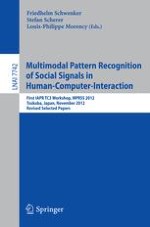2013 | Book
Multimodal Pattern Recognition of Social Signals in Human-Computer-Interaction
First IAPR TC3 Workshop, MPRSS 2012, Tsukuba, Japan, November 11, 2012, Revised Selected Papers
Editors: Friedhelm Schwenker, Stefan Scherer, Louis-Philippe Morency
Publisher: Springer Berlin Heidelberg
Book Series : Lecture Notes in Computer Science
